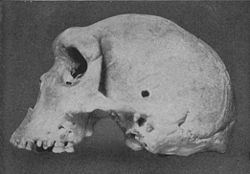Homo rhodesiensis
Homo rhodesiensis (Rhodesiamennesket) er en utdødd menneskeart som levde i Afrika for mellom 600 000 og 274 000 år siden. Det er et artsnavn som ble foreslått av Arthur Smith Woodward (1921) for å klassifisere Kabwe 1 ("Kabweskallen" eller "Broken Hill skallen", og "Rhodesiamannen"), et steinalder fossil som ble funnet i en hule i Broken Hill, eller Kabwe, Northern Rhodesia (idag Zambia).[1]. Skallen er datert til å være mellom 324,000 og 274,000 år gammel. Andre lignende funn er også gjort.[2]
| Homo rhodesiensis | |||
|---|---|---|---|

| |||
| Nomenklatur | |||
| Homo rhodesiensis Arthur Smith Woodward, 1921 | |||
| Populærnavn | |||
| Rhodesiamennesket | |||
| Klassifikasjon | |||
| Rike | Dyreriket | ||
| Rekke | Ryggstrengdyr | ||
| Klasse | Pattedyr | ||
| Orden | Primater | ||
| Overfamilie | Menneskeaper | ||
| Familie | Store aper | ||
| Slekt | Menneskeslekten | ||
| Alder | 600 000 – 274 000 år siden | ||
| Økologi | |||
| Habitat: | Afrika | ||
| Utbredelse: | Sør-Afrika, Rhodesia, Tanzania, Etiopia | ||
Homo rhodesiensis er nå for det meste betraktet som et synonym med Homo heidelbergensis, eller en afrikansk underart av Homo heidelbergensis sensu lato, forstått som en polymorf art som var spredt utover Afrika og Eurasia under pleistocenperioden (0.8–0.12 mya).[3] Andre benevnelser som Homo sapiens arcaicus[4] og Homo sapiens rhodesiensis[5] har også blitt foreslått. White et al. (2003) forslo Rhodesian Man som stamfaren til Homo sapiens idaltu (Hertomennesket).[6]
Mellom Homo sapiens og Homo rhodesiensis er det et fossilt gap på 400,000 til 260,000 år.[7]
Referanser
rediger- ^ «GBIF 787018738 Fossil of Homo rhodesiensis Woodward, 1921». GBIF org. Besøkt 9. desember 2015.
- ^ Grün, Rainer; Pike, Alistair; McDermott, Frank; Eggins, Stephen; Mortimer, Graham; Aubert, Maxime; Kinsley, Lesley; Joannes-Boyau, Renaud; Rumsey, Michael; Denys, Christiane; Brink, James; Clark, Tara; Stringer, Chris (1. april 2020). «Dating the skull from Broken Hill, Zambia, and its position in human evolution». Nature. 580 (7803): 372–375. doi:10.1038/s41586-020-2165-4.
- ^ Mounier, Aurélien; Condemi, Silvana; Manzi, Giorgio (20. april 2011). «The Stem Species of Our Species: A Place for the Archaic Human Cranium from Ceprano, Italy». PLOS ONE. 6 (4): e18821. PMC 3080388 . PMID 21533096. doi:10.1371/journal.pone.0018821. "Ceprano clusters in our analysis with other European, African and Asian Mid-Pleistocene specimens – such as Petralona, Dali, Kabwe, Jinniu Shan, Steinheim, and SH5 – furnishing a rather plesiomorphic phenetic link among them. On the basis of this morphological affinity, it seems appropriate to group Ceprano with these fossils, and consider them as a single taxon. The available nomen for this putative species is H. heidelbergensis, whose distinctiveness stands on the retention of a number of archaic traits combined with features that are more derived and independent from any Neandertal ancestry. [...] This result would suggest that H. ergaster survived as a distinct species until 1 Ma, and would discard the validity of the species H. cepranensis [...] Thus we can include the so-called “Ante-Neandertals” from Europe in the same taxonomical unit with other Mid-Pleistocene samples from Africa and continental Asia. Combining the results of the two approaches of our phenetic analysis, Ceprano should be reasonably accommodated as part of a Mid-Pleistocene human taxon H. heidelbergensis, which would include European, African, and Asian specimens. Moreover, the combination of archaic and derived features exhibited by the Italian specimen represents a “node” connecting the different poles of such a polymorphic humanity."
- ^ H. James Birx (10. juni 2010). 21st Century Anthropology: A Reference Handbook. SAGE Publications. s. 48. ISBN 978-1-4522-6630-5.
- ^ Bernard Wood (31. mars 2011). Wiley-Blackwell Encyclopedia of Human Evolution, 2 Volume Set. John Wiley & Sons. s. 761–762. ISBN 978-1-4443-4247-5.
- ^ White, Tim D.; Asfaw, B.; DeGusta, D.; Gilbert, H.; Richards, G. D.; Suwa, G.; Howell, F. C. (2003). «Pleistocene Homo sapiens from Middle Awash, Ethiopia». Nature. 423 (6491): 742–747. PMID 12802332. doi:10.1038/nature01669.
- ^ Hublin, J.-J. (2013), "The Middle Pleistocene Record. On the Origin of Neandertals, Modern Humans and Others" in: David R. Begun (ed.), A Companion to Paleoanthropology, John Wiley, pp. 517-537 (summary 529–531). "Most, if not all, of the African specimens assigned to H. rhodesiensis (cf heidelbergensis) seem to predate the divergence between H. neanderthalensis and H. sapiens [viz., assumed at 0.5 Mya prior to the revision by Meyer et al. 2016]. However, a gap in the fossil record, possibly between 400 and 260 ka, blurs the transition or punctuation event that separated H. rhodesiensis and H. sapiens." (p. 532).